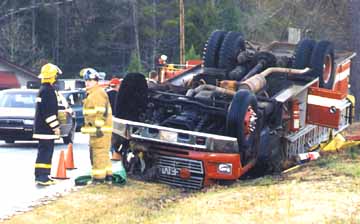 The Gay Uncle received a call from a Daddy friend the other day (we’ll call him Josh), asking how to retrofix a parenting situation he felt he’d just flubbed. Josh was watching as his nearly three year-old son was playing on some riding toys in the playroom of their apartment building. The boy was pretending to be a firefighter, an occupation which, apparently, involved pushing all the other kids’ vehicles out of the way and screaming “I’m a fireman!” (Maybe they were parked in front of a hydrant or a burning building?) Josh kept trying to corral his son, saying “No,” “Stop pushing,” and “That’s not nice,” but to little effect. Eventually, the rescue work escalated to a fiery frenzy, and he watched as his son got out of his truck, reached into one of the other vehicles, and firmly bitch-slapped the driver. Reeling in horror, Daddy firmly grabbed his son’s arm, dumped him in his stroller, and removed him from the scene. The boy howled the entire way back to the apartment, screaming in his own defense, I’m a fireman! I’m a fireman! “I felt like the other parents in the playroom were sort of on his side,” Daddy told the G.U. “What should I have done different?”
The Gay Uncle received a call from a Daddy friend the other day (we’ll call him Josh), asking how to retrofix a parenting situation he felt he’d just flubbed. Josh was watching as his nearly three year-old son was playing on some riding toys in the playroom of their apartment building. The boy was pretending to be a firefighter, an occupation which, apparently, involved pushing all the other kids’ vehicles out of the way and screaming “I’m a fireman!” (Maybe they were parked in front of a hydrant or a burning building?) Josh kept trying to corral his son, saying “No,” “Stop pushing,” and “That’s not nice,” but to little effect. Eventually, the rescue work escalated to a fiery frenzy, and he watched as his son got out of his truck, reached into one of the other vehicles, and firmly bitch-slapped the driver. Reeling in horror, Daddy firmly grabbed his son’s arm, dumped him in his stroller, and removed him from the scene. The boy howled the entire way back to the apartment, screaming in his own defense, I’m a fireman! I’m a fireman! “I felt like the other parents in the playroom were sort of on his side,” Daddy told the G.U. “What should I have done different?”
As usual, Gunc had a few pieces of advice.
1) Avoid blank commands like No and Stop when giving instructions: These kinds of decrees, when used alone and without further direction, strand kids in an abstract nether-zone, where the behavior they’re engaged in is being prohibited, but they’re not offered a viable replacement. Kids have a difficult time thinking outside of the proximal and the present tense. They need guidance. Use the G.U.’s patented E.A.R. method (Explain, Adjust, Redirect). For example, “Pushing other kids’ cars bothers them, and can hurt. Let them drive on their own. If you want to push something else around, use these traffic cones, or pillows.”
2) Not nice: Nice is a weak and ill-defined term. Kids often don’t understand the impact of their actions, and a word like “nice” doen’t really help. Guide their comprehension of cause and effect by being concrete and specific. Say, “Hitting hurts,” or “Pushing is dangerous.”
3) Set expectations and repercussions in advance: This is the big one. Part of why the little boy (and the other moms) responded like they did was because the dad hadn’t been clear about boundaries and responses. Provide warnings, and let your kid know what’s going to happen if they don’t adhere. Then, when you swoop in to follow through, your kid might still scream, but at least you won’t have to feel guilty. And you’ll know that you’re providing useful lessons for them (your will is law, you mean what you say, actions have effects) instead of just being reactive. Granted this is difficult in situations where your child gets violent (It hits! It’s evil!) But you need to get beyond this embarrassment, shame, and terror. Kids make mistakes. But they expect the grown ups around them to know better.